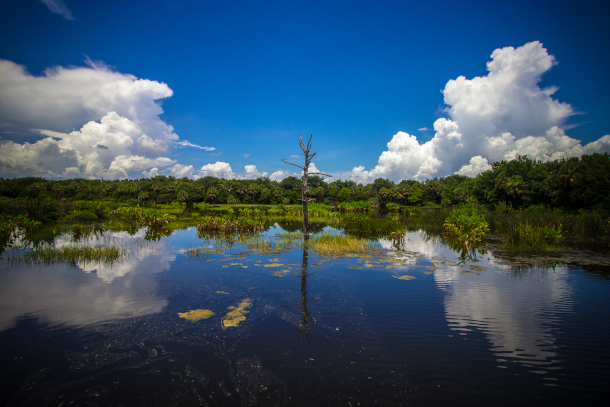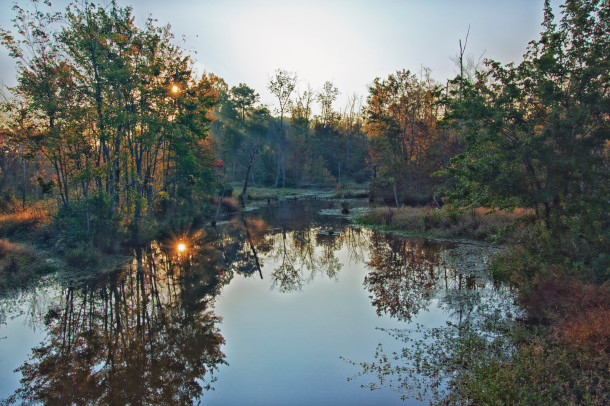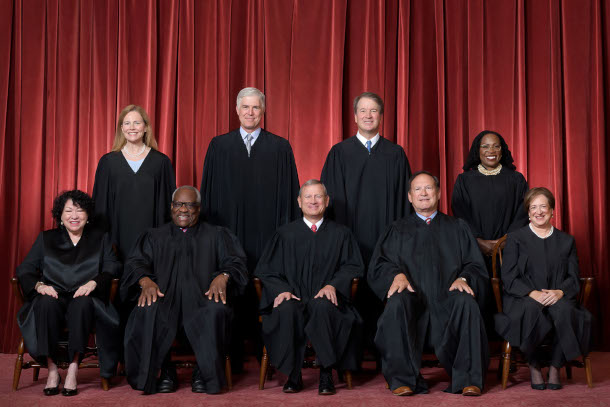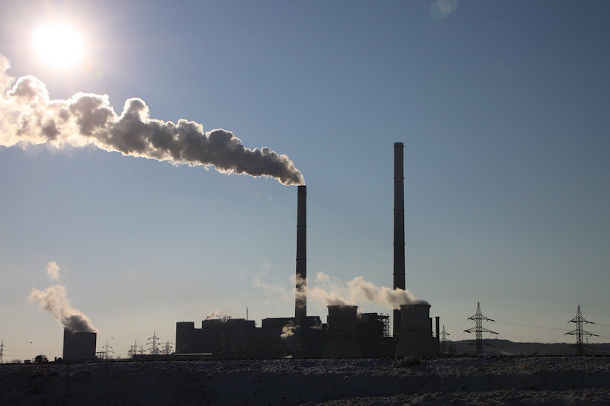Supreme Court Strips Away Wetlands Protections
Air Date: Week of June 2, 2023

The Waters of the United States (WOTUS) are protected under the Clean Water Act of 1972, and now the Supreme Court has redefined which waters apply. (Photo: Robin Mehdee, Flickr, CC BY-NC-ND 2.0)
In a decision reversing five decades of legal precedent, the U.S. Supreme Court effectively stripped environmental protections from nearly half of the wetlands in the nation. Veteran environmental lawyer Pat Parenteau joins Host Steve Curwood to explain the ruling and its impact.
Transcript
DOERING: From PRX and the Jennifer and Ted Stanley Studios at the University of Massachusetts Boston, this is Living on Earth. I’m Jenni Doering.
CURWOOD: And I’m Steve Curwood.
On May 25th, the United States Supreme Court effectively stripped environmental protections from many waterways, including nearly half of the 118 million acres of wetlands in the nation. The decision reverses much of the regulatory authority used by agencies for more than fifty years under the 1972 Clean Water Act. All nine justices agreed that after years of litigation the Sackett family in Idaho had been improperly blocked from construction on a wetland near a lake, under an appeals court ruling that had cited “significant nexus,” a term all the justices found to be too vague. But then five of the most conservative justices went much further. As a young lawyer, Pat Parenteau helped Congress deal with wetlands issues. He is now an emeritus professor of law at Vermont Law School and he’s here to help us make sense of it all. Pat, welcome back to Living on Earth!
PARENTEAU: Hey, Steve, it's good to be back with you.
CURWOOD: What exactly is this ruling that Supreme Court has come to now?
PARENTEAU: So, the Supreme Court has now said the only waters that are protected under federal law, under the Clean Water Act, are those waters that are relatively permanent, this would be big rivers, big lakes, and of course, the oceans, and wetlands that abut or adjoin those big water bodies and are indistinguishable from the big water bodies.
CURWOOD: Let me see if I understand this ruling correctly. So if there is a place that rains come to occasionally, and there's flash flooding from that, to what extent does this now mean that such places are not covered by the Clean Water Act?

Wetlands conservation is critical to combatting biodiversity loss and climate change. (Photo: Jim Liestman, Flickr, CC BY-NC-ND 2.0)
PARENTEAU: Yes, we call those streams ephemeral streams. And they only flow in response to major rain events. So those are out now. Historically, they have been protected. This new decision raises a real question about whether any intermittent stream is still protected. We'll have to wait to see how EPA and the Corps interprets this decision, because now they're going to have to go back yet again for almost the fourth time, in the last, say, 10 years, and come up with a new rule. So, we don't really know the full extent of the impact this Sackett decision will have. We know it's going to greatly reduce federal protection for streams and wetlands across the United States. There are some estimates that have predicted it will mean the loss of protection for over 50% of the wetlands in the United States. So it's honestly a devastating blow to water quality, and to wetland conservation and wetlands in particular.
CURWOOD: And in your words, why are wetlands important?
PARENTEAU: When you think about the two major global challenges that are facing us today, it's climate change and it’s biodiversity loss. And wetlands are critical to both of those. Wetlands store carbon, wetlands store floodwaters. So they're very important to both climate mitigation and adaptation. And they are the home of over half of the listed endangered species in the United States. So, the United States Supreme Court has dealt a devastating blow to natural resources in the United States.
CURWOOD: Pat, help me here. I'm a bit confused by this ruling, because it looks like all nine members of the Supreme Court ultimately concurred in the decision. But there seems to be a lot of dissent. Who voted for what, and why?

The Roberts Court is composed of nine Justices, six of whom lean conservative. Back row (left to right): Amy Coney Barrett, Neil Gorsuch, Brett Kavanaugh, and Ketanji Brown Jackson. Front row (left to right): Sonia Sotomayor, Clarence Thomas, Chief Justice John Roberts, Samuel Alito, and Elena Kagan (Photo: Fred Schilling, Collection of the Supreme Court of the United States, public domain)
PARENTEAU: All nine voted that the Sacketts should win based on the significant nexus test. But five justices led by Justice Alito voted for three things. One, the significant nexus test that the Ninth Circuit used was wrong. Two, that the Sackett wetland was not protected by the Clean Water Act. And three, the big one, for all future jurisdictional determinations, the agencies must now use the following two tests. One, the river, the stream, the lake, the pond, all of those water bodies must be relatively permanent, like big rivers, big lakes and the ocean. And two, wetlands, in order to be jurisdictional, must immediately adjoin those major water bodies, okay? Five justices, Alito, Thomas, Gorsuch, Barrett, and Chief Justice Roberts, that's the majority vote. The other four justices, Kavanaugh, Kagan, Sotomayor, and Jackson, agreed that the significant nexus test was not the proper test, and that the Sackett wetlands were not protected by the Clean Water Act. But those four justices completely rejected this new test of relatively permanent rivers and streams and lakes, and only adjoining wetlands. That's what those four voted for.
CURWOOD: Pat, the current makeup of the US Supreme Court leans conservative, with six of the nine justices appointed by Republican presidents, three alone by President Trump. To what extent did the Sackett decision split down the lines of conservative versus liberal, or what kind of crossover is there on this issue?

The 6-3 ruling in West Virginia v. EPA holds that EPA needs clearer direction from Congress in order to regulate emissions from power plants by requiring states to use more gas, solar and wind to generate electricity. (Photo: Emilian Robert Vicol, Flickr, CC BY 2.0)
PARENTEAU: Here's the thing. The judgment means we're reversing the Ninth Circuit's use of this significant nexus test. So, on that point, the liberal wing of the court, including Justice Kavanaugh, who's not a member of the liberal wing, they all agreed that that was the wrong decision by the Ninth Circuit. But Kagan and company would have stopped at that point, and not gone further and developed this brand-new test that I've described, to control all the waters of the United States. They said that's overreach by the Court. The most interesting opinion was by Justice Kavanaugh, who agreed that the significant nexus test was wrong, but he vehemently disagreed with Justice Alito's decision to rewrite, in essence, the jurisdiction of the Clean Water Act. He said, you've ignored 45 years of precedent, including precedents by the Supreme Court, across eight different administrations, and countless number of Congresses. You've just completely overridden all of that history, both judicial and legislative, and come up with your own policy decision on what waters should be protected. Very strong language from Justice Kavanaugh. So that's very striking. No surprise that the Kavanaugh opinion was joined by Justices Kagan, Sotomayor, and Jackson. Kagan also wrote her own opinion, which was even more scalding and basically saying, this Court is losing the respect it needs, in the way that we are making decisions that lack the kind of respect for precedent, the kind of deference to the expert agencies, deference to Congress's decisions about what the purposes of these laws are and why they're important, and arrogating, to itself, decisions that simply don't belong in this Court, in the Supreme Court. So, I think you're seeing that now we have, you know, a more authoritarian kind of ruling coming out of the Court, leaving the agencies with very little discretion about how to adapt to the different topographical, hydrological conditions that exist in the United States. This idea that a decision from a tiny little wetland in northern Idaho now controls the scope of regulation of water quality throughout the entire United States is really unprecedented.
CURWOOD: Now, Pat, in 2022, the Supreme Court also limited the EPA's power in terms of the Clean Air Act. And when we talked to you about that, you said it was disheartening to see the Court make that decision. How are you feeling now after this wetlands case, after this waters of the United States case?

Pat Parenteau is emeritus professor of law at Vermont Law School and formerly served as EPA Regional Counsel. (Photo: Courtesy of Vermont Law School)
PARENTEAU: I've got my life's work tied up in clean water and wetland protection. That's what I've done my whole career. And to see it so cavalierly thrown aside, is soul-crushing. You have to wonder now as an environmental lawyer, is any of these environmental rules safe from this Court, right? The West Virginia case dealt a devastating blow to EPA's authority to regulate greenhouse gases from power plants. And even worse than that, did so using this new doctrine called the major question, which basically means the Supreme Court will decide, without regard to the agency's views at all, what the words of a statute mean, even where Congress has been intentional to leave open interpretation of some of the text that they write into the laws simply because Congress realizes it doesn't know everything. It can't spell out, in detail, every aspect of every environmental regulation on the books. It has to rely on expert agencies to use their expertise in judgment to fill in the gaps. So that's what is so disturbing about where we are today with what the Supreme Court is doing to environmental law. It is dismantling it, one by one. These are the two major statutes: air quality, water quality. These are the laws that began the environmental era in the United States, and they have blown holes in both of those major pillars of environmental law. What's next, is the question.
CURWOOD: Pat Parenteau is a former EPA regional counsel and emeritus professor at Vermont Law School. Pat, thanks so much for taking the time with us today.
PARENTEAU: You're very welcome, Steve. I wish it could have been a happier moment.
Links
Supreme Court | “Sackett v. EPA”
Supreme Court | “West Virginia v. EPA”
EPA | “Statement on Supreme Court Decisionin Sackett v. EPA”
Living on Earth wants to hear from you!
Living on Earth
62 Calef Highway, Suite 212
Lee, NH 03861
Telephone: 617-287-4121
E-mail: comments@loe.org
Newsletter [Click here]
Donate to Living on Earth!
Living on Earth is an independent media program and relies entirely on contributions from listeners and institutions supporting public service. Please donate now to preserve an independent environmental voice.
NewsletterLiving on Earth offers a weekly delivery of the show's rundown to your mailbox. Sign up for our newsletter today!
 Sailors For The Sea: Be the change you want to sea.
Sailors For The Sea: Be the change you want to sea.
 The Grantham Foundation for the Protection of the Environment: Committed to protecting and improving the health of the global environment.
The Grantham Foundation for the Protection of the Environment: Committed to protecting and improving the health of the global environment.
 Contribute to Living on Earth and receive, as our gift to you, an archival print of one of Mark Seth Lender's extraordinary wildlife photographs. Follow the link to see Mark's current collection of photographs.
Contribute to Living on Earth and receive, as our gift to you, an archival print of one of Mark Seth Lender's extraordinary wildlife photographs. Follow the link to see Mark's current collection of photographs.
 Buy a signed copy of Mark Seth Lender's book Smeagull the Seagull & support Living on Earth
Buy a signed copy of Mark Seth Lender's book Smeagull the Seagull & support Living on Earth

